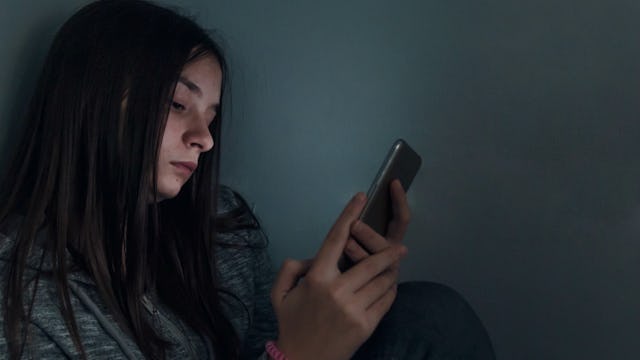Mental Health Issues In Teens Have Significantly Increased Over Past Decade

Back in the ’90s, when I was a teen, sullen seemed to be in. Dark hair matched dark moods, and there were times when I honestly thought we invented the depressed, disinterested teenager vibe.
Was I actually depressed as a teenager? Well… yes, actually. I was. That’s when my life-long struggle with depression started to take shape, but I don’t believe all of us were clinically depressed. Many of us were just putting on that black eyeliner as part of an act.
Back in the ’90s, we hung out in the same room to talk about how much we hated our parents. We went to Blockbuster together. When our pager beeped, we had to actually call someone instead of sending them a text. We even rode in the same car. The majority of our interactions were face to face — and it turns out, teens were a lot happier then.
Not that this will shock anyone raising children in 2019, but teens of the 2010’s predominantly interact online, and it’s having a huge impact on their mental health. According to a recent study in the Journal of Abnormal Psychology, “More U.S. adolescents and young adults in the late 2010s, versus the mid-2000s, experienced serious psychological distress, major depression or suicidal thoughts, and more attempted suicide.”
The lead author of this study, Jean Twenge, PhD, and professor of psychology at San Diego State University said that, “These trends are weak or non-existent among adults 26 years and over, suggesting a generational shift in mood disorders instead of an overall increase across all ages.”
My oldest is a preteen, and like any parent falling into this age group, these statistics freaked me out a bit. But what I think made me even more anxious was when I read the scope of this study, and realized how much mental illness had increased. They looked at survey responses of more than 200,000 adolescents age 12 to 17 from 2005 to 2017, and almost 400,000 adults age 18 and over from 2008 to 2017. I don’t want to state the obvious, but that’s a pretty large sampling.
What they found was extremely alarming. The rate of individuals reporting symptoms consistent with major depression in the last 12 months increased 52 percent in adolescents from 2005 to 2017 and 63 percent in young adults age 18 to 25 from 2009 to 2017. There was also a 71 percent increase in young adults experiencing serious psychological distress in the previous 30 days from 2008 to 2017. The rate of young adults with suicidal thoughts or other suicide-related outcomes increased 47 percent from 2008 to 2017.
I suffer from depression and anxiety, and I come from a long line of family members with mental illness, so I watch my kids pretty closely for signs of depression because I know how important it is to manage your mental illness. But what really hit me was that the authors of this study didn’t feel that this increase had anything to do with genetics or socioeconomic status, but rather lifestyle.
“Cultural trends in the last 10 years may have had a larger effect on mood disorders and suicide-related outcomes among younger generations compared with older generations,” said Twenge. She believes this trend may be partially due to increased use of electronic communication and digital media, which may have changed social interaction enough to affect mood disorders in teens. This was hands down the major contributor to this increase in depression.
But there was another related factor, and that was lack of sleep. Naturally, these two are intertwined. What this study found is that teens are spending more time awake late at night, interacting online, and it is contributing to their depression.
Now I’m with you, as a father of three, the last thing I want to do is monitor my children’s online activity in the middle of the night. But I must say, just a few weeks ago, I found my preteen in our living room playing games and live chatting with his friend at 4:30 a.m. on a school day. Who knows how many times he’d pulled that move and I’d slept through it. He now has to check in all his devices before going to bed.
As much as this should all give parents pause, the positive side is that you can change a lifestyle a lot easier than you can change genetics. And I know, I know, getting teenager to do literally anything they don’t want to can be a serious challenge, and asking them to put down their phone for even a moment feels a lot like severing a limb. But it is possible, and after reading this study, it might just be very necessary. And this is exactly what the authors of this study concluded.
“Young people can’t change their genetics or the economic situation… but they can choose how they spend their leisure time,” the study’s author’s wrote. “First and most important is to get enough sleep. Make sure your device use doesn’t interfere with sleep…don’t keep phones or tablets in the bedroom at night, and put devices down within an hour of bedtime. Overall, make sure digital media use doesn’t interfere with activities more beneficial to mental health such as face-to-face social interaction, exercise and sleep.”
As someone who had learned to live with depression and anxiety, I can say confidently that lifestyle changes can help (along with medication and therapy, in some cases). And I get it, asking parents to add one more thing to their ever-growing list of things that will benefit their children can feel overwhelming. But the sad fact is, managing screen time and online interactions is what it looks like raising teenagers in 2019, and as this study pointed out, the stakes for online management have never been higher.